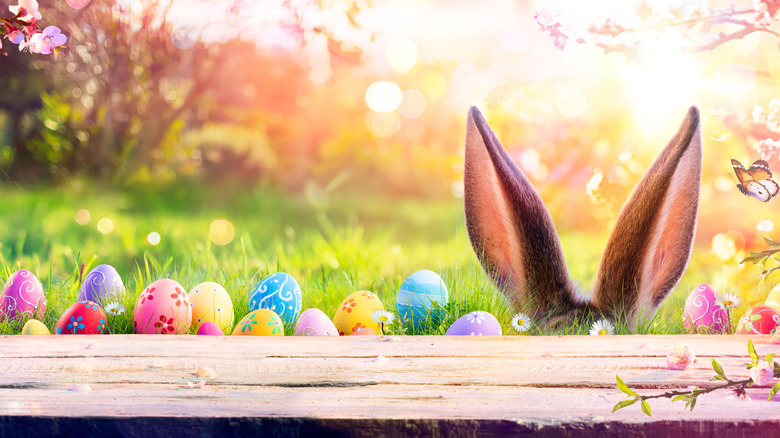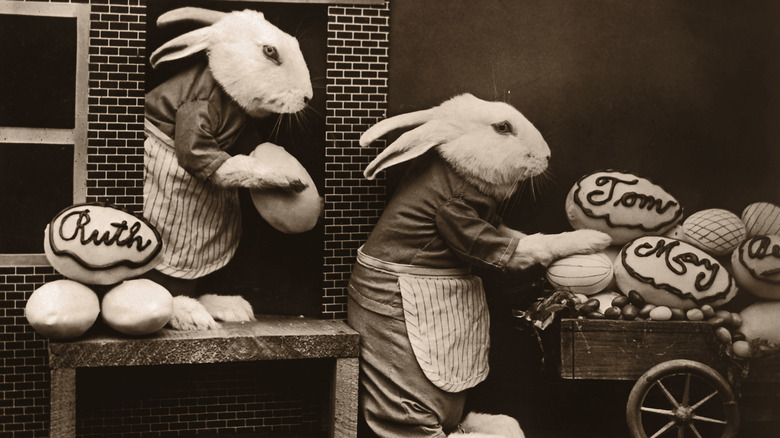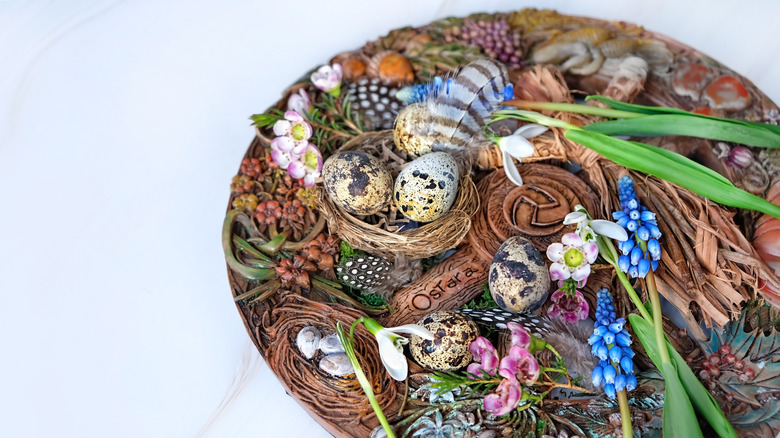What Does The Easter Bunny Have To Do With Eggs?
Every Easter Sunday, children throughout the Christian world honor the resurrection of Christ by gathering colorful eggs left by an anthropomorphic rabbit. No matter how you cut it, that's a weird sentence. The holiday seems to be a hodgepodge of symbols all mixed together with whimsical abandon and a complete disregard for the rules of mammalian reproduction ... but why?
The Bible makes no mention of an Easter Bunny or egg hunts, and the origin of these symbols is a bit muddy. The first recorded evidence of the Easter Bunny didn't come until 1682, and arose — of all places — from a collection of medical essays by Johannes Richier, a German doctor and theologian. Richier wrote a dissertation that mentions a West German character named Osterhase, or "Easter Hare," who was said to hop from garden to garden on Easter Sunday, laying colorful eggs for children to find.
It's likely that the Easter Bunny entered American culture in the 1700s, when German immigrants brought the fable of Osterhase to Pennsylvania. From there, it spread to become a ubiquitous part of the holiday throughout the United States. Unfortunately, prior to Richier's 1682 essay, there is almost nothing to go on regarding the origin of Osterhase and why this particular rabbit laid eggs. However, many historians believe that bunnies and eggs became symbols of Easter independently, and were later combined into one myth. What do rabbits and eggs have in common? It's all about new life.
Rabbits and eggs are both symbols of fertility
Easter celebrates the resurrection of Jesus; and it occurs in the spring, a season when trees and fields made barren by winter come back to life. It's a celebration of rebirth, so it should come as no surprise that the holiday would become connected to other symbols of life and fertility. Rabbits and hares are famous for their extremely high rates of reproduction, with females giving birth to as many as 60 kits per year. Hares are also capable of getting pregnant for a second time while they're already pregnant. This led people in the past to mistakenly believe rabbits could reproduce asexually, equating them to the virgin birth of Jesus. Renaissance paintings, like "The Madonna of the Rabbit" by Titian, began to use white rabbits as a symbol of Mary's purity.
It's not hard to see where eggs fit into the picture here. Being a source from which new life springs, they represent the resurrection as well. But there is an even deeper significance to the use of eggs as an Easter symbol. Easter marks the end of Lent, a time in which Christians were historically prohibited from eating eggs. Instead, they would save up their eggs and decorate them before finally breaking them open to eat as part of an Easter feast. This tradition appears to predate the concept of the Easter Bunny by a few centuries, with the practice of decorating Easter eggs going back to the 1200s.
These Easter symbols are rooted in pagan celebrations
There's a reason that rabbits and eggs feel a bit out of place amidst the Easter mythos. Unlike the tradition of serving lamb on Easter, these symbols are not taken from Christianity. Instead, they were co-opted from a pagan celebration that originated in England. The polytheistic pagans celebrated the spring equinox with a festival honoring Eostre — the goddess of dawn, spring, and fertility — who was associated with the symbol of a hare.
In the 6th century, Pope Gregory sent missionaries to England to spread Catholicism. Rather than forcing the pagans to change their entire belief system on the spot, the missionaries gradually incorporated elements of Catholicism into preexisting pagan holidays. The winter festival of Yule became Christmas, and Eostre became Easter, but they still retained some elements of their pagan roots. As you've probably guessed, the word Easter is derived from Eostre, and is unique to English. Nearly every other language uses a variation of the Latin word pascha, from which Passover is also derived.
In the 1800s, Jacob Grimm (of the Brothers Grimm) heard the legend of Eostre and decided to incorporate her into German folklore under the name Ostara. Since she was already associated with hares, her story was ultimately combined with that of Osterhase. This provoked a legend in which Ostara rescues a wounded bird by transforming it into a hare, and it goes on to lay colorful eggs for her festival, just as the Easter Bunny does today.


